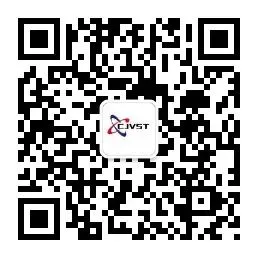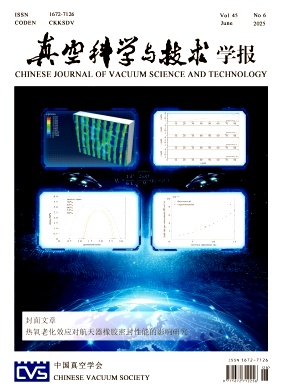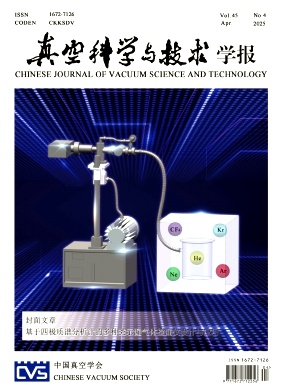
Tracking the information about your manuscript
Communicate with the editorial office
Query manuscript payment status Edit officeCollecting, editing, reviewing and other affairs offices
Managing manuscripts
Managing author information and external review Expert Information Expert officeOnline Review
Online Communication with the Editorial Department
Editor-in-chief

LIU Yichun
Academician of Chinese Academy of Sciences,

关注公众号,获取最新文章
About the Journal
 Chinese Journal of Vacuum Science and Technology (CJVST) is national level scientific journal operated by the Chinese Vacuum Society and approved by the Chinese Association for Science and Technology. CJVST pressed the first volume in 1981. Since then, CJVST has been listed as a Chinese Science Citation Database (CSCD) journal and Chinse Core Journal. CJVST publishes Chinese and English research papers on vacuum acquisition, improvement, testing, and application, involving the intersection of physics, chemistry, engineering, materials, biology and other disciplines.
Chinese Journal of Vacuum Science and Technology (CJVST) is national level scientific journal operated by the Chinese Vacuum Society and approved by the Chinese Association for Science and Technology. CJVST pressed the first volume in 1981. Since then, CJVST has been listed as a Chinese Science Citation Database (CSCD) journal and Chinse Core Journal. CJVST publishes Chinese and English research papers on vacuum acquisition, improvement, testing, and application, involving the intersection of physics, chemistry, engineering, materials, biology and other disciplines.
Cover Aticle
Structure Analysis and Optimization of Vacuum Pump Station of Horizontal Test Platform of Superconducting Acceleration Cryomodule
Investigation of Thermo-Oxidative Aging Effects on Sealing Performance of Spacecraft Elastomeric Seals
Design and Application of Multi-Species Gas Leak Detector Based on Quadrupole Mass Spectrometer Analyzer
Tactful Use of Low Angle Electrons in Scanning Electron Microscope
Research Progress of High-Pressure Cryopreservation for Multiscale Living Materials
more..Research on Atomic Manipulation and Patterning on Kagome Structure Surface
ZHOU Zhenru;WANG Tingting;FAN Haolong;LI Yan;HAO Xiaoyu;ZHAN Lingtao;CAO Xiongbai;YU Qinze;YANG Huixia;ZHANG Teng;ZHANG Quanzhen;CHEN Lan;WANG Yeliang;GAO Hongjun;Atomic manipulation technique plays a significant role in the controllable construction of novel quantum structures, the regulation of exotic physical properties, and the exploration of application prospects for new nano-electronic devices. Currently, most atomic manipulations are carried out on metal surfaces such as Cu(111)and Au(111), and on semiconductor surfaces such as Si and InAs. However, atomic manipulation in the field of Kagome structures has rarely been explored. In this research work, we have, for the first time, achieved precise manipulation of potassium(K) atoms and the construction of atomic patterns on the Sb surface of the Kagome KV3Sb5 through the ultra-high precision atomic manipulation technique of scanning tunneling microscopy(STM).By using the STM probe to controllably slide and push K atoms, we have overcome the interference caused by the potential energy fluctuations on the Sb surface to directional atomic movement, successfully migrated K atoms along the lattice basis vectors for single and continuous multiple lattice spacings, and constructed a regular “BIT”atomic pattern. In addition, the experimental results have shown that the anisotropic potential energy benchmark provided for K atoms by the charge density wave(CDW)-induced symmetry breaking on the Sb surface significantly improves the manipulation accuracy. This research not only expands the application scope of atomic manipulation technique and demonstrates the feasibility of STM for atomic-level manipulation on complex Kagome material surfaces, but also provides important experimental evidence for the directional design of future nanoelectronic devices at the atomic scale.
Mediated Wafer-Scale Growth of Full-Coverage Monolayer MoS_2
ZUO Haosong;LIU Yihe;CHEN Kuanglei;XU Rufeng;ZHANG Zheng;ZHANG Xiankun;ZHANG Yue;As a key candidate material for integrated circuits in the post-Moore era, wafer-scale high-quality preparation of two-dimensional molybdenum disulfide(MoS2) is fundamental for its industrial application. While chemical vapor deposition(CVD) on sapphire substrates enables large-area MoS2 film growth, it is constrained by non-uniform molybdenum source deposition resulting from weak adsorption of gaseous MoO3 at the Al-O interface,leading to film wrinkling and crack defects. This study proposes a growth strategy employing an Al-O-Mo-O chemical bonding modification layer on the substrate surface, successfully fabricating a uniform, continuous, and high-coverage 2-inch wafer-scale monolayer MoS2 film. By maintaining a stable oxygen atmosphere during the preannealing deposition step, this method simultaneously eliminates dangling bonds on the sapphire surface and constructs an Al-O-Mo-O modification layer. This layer provides stable anchoring sites for gaseous MoO3 deposition, enhancing its adsorption at the interface and promoting uniform adsorption, deposition, and sulfurization of the molybdenum precursor across the substrate. Consequently, a high-coverage monolayer MoS2 film is achieved.Top-gated transistor arrays fabricated from this film exhibit excellent performance uniformity, with a maximum on/off ratio of 107, a maximum on-state current of 10-5 A, and a device yield exceeding 96%. The substrate modification method presented in this work provides a novel approach for the controllable preparation of highquality MoS2 films on sapphire, optimizes existing fabrication processes, and holds significant promise for advancing the application of two-dimensional materials in integrated circuits.
Development and Future Trends of Cryogenic Technology
LIN Yujie;PAN Changzhao;LIU Xuming;YU Dapeng;Since the Industrial Revolution, advancements in cryogenic technology have significantly accelerated due to the successful liquefaction of gases such as nitrogen, hydrogen, and helium, accompanied by the discovery of superconductivity. This article reviews the historical progression of cryogenic technology, tracing its evolution from the passive utilization of natural ice through the establishment of thermodynamic theories and breakthroughs in active refrigeration, particularly emphasizing the discovery of the Joule-Thomson effect and superconductivity. Fundamental cryogenic principles are described, including adiabatic expansion, throttling processes, and vapor-compression refrigeration cycles, with detailed discussions on three representative cryogenic devices: the Gifford-McMahon(G-M) cryocooler, the pulse tube cryocooler and dilution refrigerator. Furthermore,the paper elaborates on the extensive applications of cryogenic technology across scientific research, industrial production, aerospace, and energy transportation fields. Finally, it offers a prospective outlook on the development trends of cryogenic technology, highlighting directions towards miniaturization, environmental sustainability, and intelligent operation.
Research on Process Optimization of L-Shaped Lithium Niobate Metasurfaces
YAO Xueying;CHANG Wenyao;GUO Zirui;LI Jianmei;GUO Yang;GU Changzhi;Lithium niobate on insulator(LNOI) combines the excellent linear and nonlinear optical properties of lithium niobate(LiNbO3) crystals with advantages of facile photonic device processing and integration, and is considered as one of the potential platforms for integrated optics. In this study, we fabricated an L-shaped LNOI metasurface structure by an inductively coupled plasma reactive ion etching system(ICP-RIE) system, and proposed an optimization strategy to enhance the traditional process. The method involves correcting the exposure pattern to precisely control the L shape, reducing the coating rate to improve mask density and uniformity, and adjusting etching gas composition by introducing hydrogen to eliminate the by-products of the sample. The experimental results show that this optimized process significantly improves the surface flatness of the L structure, increases the sidewall steepness, and ensures the dimensional conformity with the theoretical design. The second harmonic generation(SHG) intensity is approximately five times higher than that of LNOI. This study promotes the development of the preparation and integration technology of lithium niobate crystal optical components.
Research Progress of Hydrogen Desorption Lithography Technology
BAO Yang;XU Hai;JING Pengtao;XU Jilian;YAN Jiaxu;ZHAN Da;LIU Lei;SHEN Dezhen;Silicon-based semiconductor technology, as the cornerstone of the semiconductor industry, has achieved manufacturing precision at the scale of a few nanometers and is now advancing toward atomic-level precision. However, due to the Rayleigh diffraction limit, traditional extreme ultraviolet(EUV) lithography is unable to meet the demands for atomic-scale precision required in future semiconductor manufacturing. As an atomically precise lithography technique, hydrogen depassivation lithography(HDL) has emerged as a strategic solution to address this challenge, owing to its exceptional spatial resolution and scalability. Leveraging the atom manipulation capabilities of scanning tunneling microscope(STM), HDL enables atomic-scale patterning by precisely controlling the desorption of hydrogen atoms on silicon surfaces. Since its introduction in the 1990s, HDL has successfully fabricated devices such as single-atom transistors and quantum logic gates, which are unattainable through traditional lithography processes, showcasing its transformative advantages. This article provides a comprehensive review of the development history and key breakthroughs of HDL technology, while also exploring its future prospects. By further improving processing efficiency and reliability, HDL technology is poised to enable widespread applications in various fields, including semiconductor manufacturing, nanoimprint technology, and quantum device manufacturing, thereby driving significant progress in the future of semiconductor technology.
News
Congratulations to the 16 editorial board members of the Journal of Vacuum Science and Technology for being selected as the "Global Top 2% Scientists"!
2024-01-04 TopCongratulations to the 7 editorial board members of the Journal of Vacuum Science and Technology for being selected as the 2022 Elsevier " Highly Cited Chinese Researchers"
2024-01-04 TopWarm congratulations
more..Journal Dynamics
211 National Societies of the China Association for Science and Technology jointly issued the Academic Publishing Ethics Convention
TopAdvances in Cryopreservation of Tissues and Organs
Top"Chinese Journal of Vacuum Science and Technology" Most Beautiful Cover Selection of the year 2021
more..



























































































































































































































































































































































